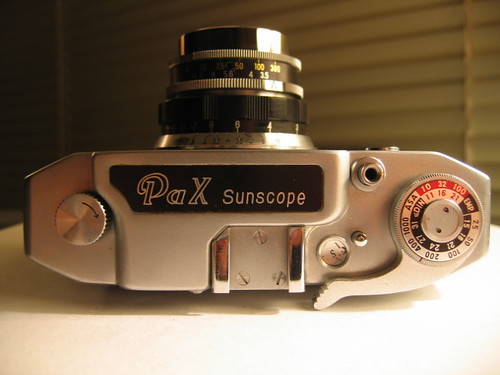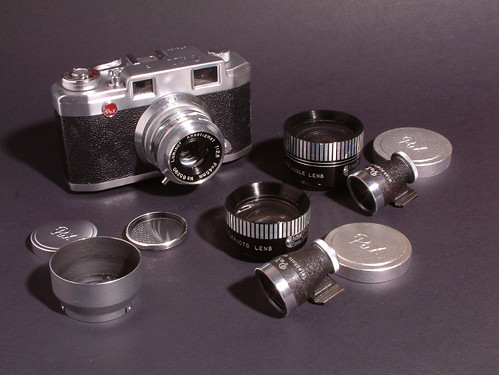Yamato

|
| Pax Sunscope (export version of Pax Ruby) image by Brian Cue (Image rights) |
Various Japanese companies have the name Yamato (大和), which is an ancient name for Japan.
Contents
Yamato Kōki Seisakusho
The April 1943 government inquiry listing Japanese camera production mentions a company called Yamato Kōki Seisakusho and based in Tokyo.[1] It was the maker of the Yamato Rapid shutter (B, 1–500) mounted on the Semi Gelto and Baby Leotax and of the Lead Rapid shutter (T, B, 1–500) mounted on the Semi Lead. It is not known if this was the same company as the postwar Yamato Kōki Kōgyō.
Yamato Kōgaku Seisakusho
Canon's company history refers to another Tokyo company, Yamato Kōgaku Seisakusho (大和光学製作所 - Yamato Optical Manufacturing Company Ltd.), which merged with Canon (then Precision Optical Industry Company; 精機光学工業株式会社) in 1944 (and so is definitely not the post-War Yamato company below).[2] This company was in Itabashi ward.
Yamato Kōki Kōgyō (Pax cameras, among others)
Yamato Kōki Kōgyō K.K. (大和光機工業㈱ - Yamato Camera Industry Company) was a Japanese camera maker.
The origin of this Yamato company is unclear. It is known that the company was already active in 1952.[3] The first cameras made for sure by Yamato were the Minon 35, Pax 35 and Minon Six. Their roots can be traced back to two different companies.
On the one hand, the Minon 35 and Pax 35 were respectively developed from the Dan 35 III and Super Dan 35. Many sources say that all the Dan 35 models distributed by Hagimoto from 1948 to 1950 were already made by Yamato, but this is unclear (see Dan 35 I and II). Another possibility would be that Yamato took over the production of the Dan models after the failure of Hagimoto in 1950.
On the other hand, the Minon Six was an evolution of the Poppy Six by Shin Nippon Kōgyō, itself a derivative of the Gotex released around 1941 by Kigawa. The original Minon Six and early Minon Six II have SNK logos and were surely made by Shin Nippon Kōgyō, and the late Minon Six II and III were advertised as made by Yamato. It is not known if the production was transferred from Shin Nippon Kōgyō to Yamato Kōki Kōgyō, or if the latter was a renaming of the former.
Yamato continued to develop the Pax line into the early 1960s. It presented the Artronic F Zoom and Artronic L prototypes, one still and one cine camera, at the Photokina in 1963, the first cameras in the world to have an electronic shutter.[4][5] The company was probably not financially strong enough to manufacture them, and all trace of it is lost after that date.
One example of the Pal Jr offered for sale in an online auction has a box printed Nihon Photo Electric Co., Ltd along the bottom half (Pax and Pal cameras are sometimes seen with boxes of the same style, printed Yamato Koki Kogyo Co., Ltd in the same place). This may suggest either that Yamato allowed Nihon Photo Electric (the lightmeter company Nihon Kōden) to market the camera under its own name, or even that Nihon Photo Electric bought Yamato (this might be consistent with the development of electronic shutters).
Another company called Yamato Kōki Kōgyō K.K. is known to exist today (2008), and currently makes microtomes (medical research instruments). It was founded in 1926 as Kikuchi Seisakusho (菊池製作所) by Kikuchi Rikichi, and took its present name in 1944.[6] The history page on its website does not mention cameras, and its address from 1952 to 1984 was in Tokyo, Shinjuku, not the same as the address of the camera maker.[7] It is thus probable that the two companies were not related.
Bolta film cameras
The Dan 35 cameras are attributed by some sources to Yamato Kōki Kōgyō, but this is unclear. The development of the Dan 35 was supervised by Hagimoto.
35mm viewfinder cameras
- Atlas 35 (also sold as Rippa[8] and (by Sears) as the Tower 55)
- Atlas 35 II
- Emitax Automatic
- Simflex 35
- Pax Jr (also sold as Pal Jr, Hilka and (by Sears) as the Tower 55B)
- Palmat Automatic (also sold as the Mini-Electro 35 and the Mansfield Skylark)
35mm rangefinder cameras
- Pax 35
- Pax M2
- Pax M3
- Pax M4 (also sold as Pal M4 and (by the Trans-American Import/Export Co) as the TAC Deluxe)
- Pax Ruby (also sold as Pax Sunscope, Rippa,[8] Riscor and Rex Kaysons)
- Skymaster
- Atlas Deluxe (RF version of the Atlas 35)
6×6 folders
The attribution of the Bonny Six to Yamato is a mistake.
Yamato Shōkai
K.K. Yamato Shōkai (㈱大和商会) was a Japanese distributor based in Tokyo, mentioned as the authorized dealer of the Flora Six in 1953.[9]
Notes

|
| The Pax M3 rangefinder camera with tele and wide converters, plus tele and wide viewfinders image by Dustin McAmera (Image rights) |
- ↑ Its address in 1943 was Tōkyō-to Mukōjima-ku Azuma-chō 8–1663 (東京都向島区吾嬬8–1663) - now part of Sumida ward. Source: "Kokusan shashinki no genjōchōsa" ("Inquiry into Japanese cameras").
- ↑ Canon Camera Story 1937-45 at the Canon Camera Museum.
- ↑ Advertisement dated July 1952 reproduced in Kokusan kamera no rekishi, p.198.
- ↑ Kokusan kamera no rekishi, p.375.
- ↑ Popular Science September 1963, pp157-158 (column Photographically Speaking) describes electronic shutter development by Canon and Yamato, among other topics; archived at Google Books.
- ↑ Official chronology of the current Yamato Kōki Kōgyō.
- ↑ Official chronology of the current Yamato Kōki Kōgyō. The exact address was Tōkyō-to Shinjuku-ku Hyakunin-chō 1–10–8 (東京都新宿区百人町1–10–8).
- ↑ 8.0 8.1 The name Rippa appears on viewfinder cameras identical to the Atlas 35, and on rangefinder cameras identical to the Pax Ruby.
- ↑ Advertisement reproduced in Kokusan kamera no rekishi, p.177.
Bibliography
- Asahi Camera (アサヒカメラ) editorial staff. Shōwa 10–40nen kōkoku ni miru kokusan kamera no rekishi (昭和10–40年広告にみる国産カメラの歴史, Japanese camera history as seen in advertisements, 1935–1965). Tokyo: Asahi Shinbunsha, 1994. ISBN 4-02-330312-7.
- "Kokusan shashinki no genjōchōsa" (国産写真機ノ現状調査, Inquiry into Japanese cameras), listing Japanese camera production as of April 1943. Reproduced in Supuringu kamera de ikou: Zen 69 kishu no shōkai to tsukaikata (スプリングカメラでいこう: 全69機種の紹介と使い方, Let's try spring cameras: Presentation and use of 69 machines). Tokyo: Shashinkogyo Syuppan-sha, 2004. ISBN 4-87956-072-3. Pp.180–7.
Links
Miscellaneous
In English:
- Boltax, Dan and Minon 35 cameras at submin.com
- Post about the Dan 35 at the Camera Collector forum
- Yamato page in the Pacific Rim Photographica Pages
- Yamato models list at cameracollector.net
In Japanese:
Pax
In English:
- Pax M3 in the Pacific Rim Photographica Pages
- Post with a Tower 55 at photo.net
- Pax 35 user manual at butkus.org's Orphan Cameras
- Gold Pax repair at Robert Ian Axford's Camera Works
In Japanese: